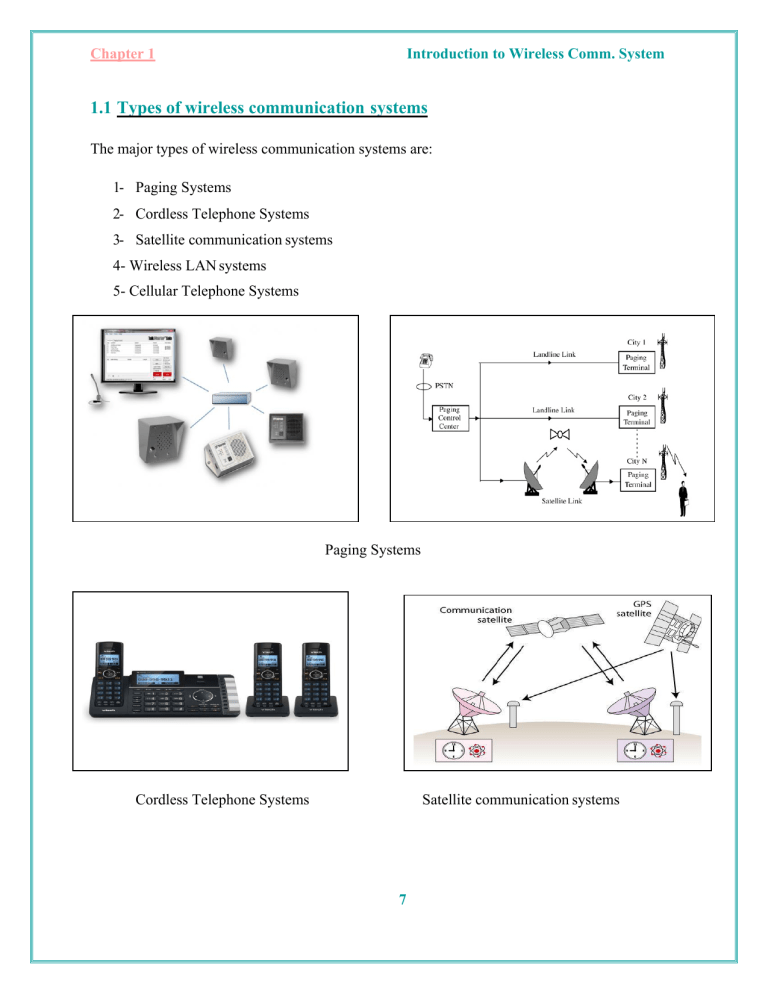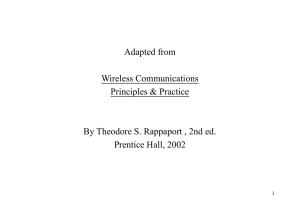
Chapter 1 Introduction to Wireless Comm. System 1.1 Types of wireless communication systems The major types of wireless communication systems are: 1- Paging Systems 2- Cordless Telephone Systems 3- Satellite communication systems 4- Wireless LAN systems 5- Cellular Telephone Systems Paging Systems Cordless Telephone Systems Satellite communication systems 7 Chapter 1 Introduction to Wireless Comm. System The cost, complexity, performance, and types of services offered by each of these mobile systems are different. 1- Paging Systems Paging systems are communication systems that send brief messages to a subscriber. Depending on the type of service, the message may be either text or voice messages. In modern paging systems, news headlines, stock quotations, and faxes may be sent. The issued message is called a page. The paging system then transmits the page throughout the service area using base stations which broadcast the page on a radio carrier. - Paging systems vary widely in their complexity and coverage area. - Paging systems are designed to provide reliable communication to subscribers. This necessitates large transmitter powers and low data rates for maximum coverage from each base station. Simple paging systems may cover a limited range of 2 to 5 km, or may even be confined to within individual buildings, Wide area paging systems can provide worldwide coverage. Wide area paging systems consist of a network of telephone lines, many base station transmitters, and large radio towers that simultaneously broadcast a page from each base station (this is called simulcasting) 2- Cordless Telephone Systems • Provide wireless extension to the telephone network within a limited area • Two-way (duplex) communications • Consists of a portable handset, connected to dedicated base station, which is connected to the telephone network • 1st generation: household environment • 2nd generation: allow mobility in workplace and public use with limited coverage in urban areas 8 Chapter 1 Introduction to Wireless Comm. System 3- Satellite communication Systems The main feature of the satellite communication systems ▪ Very wide range and coverage ▪ Very useful in sparsely populated areas: rural areas, sea, mountains, etc. ▪ Target: Vehicles and/or other stationary/mobile uses ▪ Expensive base station (satellites) systems 4- Wireless LAN (WLAN) Characterized by ▪ Low mobility (not for vehicular use) ▪ High speed data transmission ▪ Confined regions – buildings and campuses ▪ Coverage: 100m – 300m per base station ▪ Uses the following bands (902-928 MHz, 2400-2483.5 MHz, 5725-5850 MHz) 5- Cellular Telephone Systems The basic cellular system consists of: Mobile station (MS), Base stations (BS) and Mobile switching center (MSC) or called Mobile telecommunications switching office (MTSO). - Cellular systems accommodate a large number of users over a large geographic area, within a limited frequency spectrum. - Cellular radio systems provide high quality service that is often comparable to that of the landline telephone systems. - High capacity is achieved by limiting the coverage of each base station transmitter to a small geographic area called a cell so that the same radio channels may be reused by another base station located some distance away. - Handoff: is a switching technique that enables a call to proceed uninterrupted when the user moves from one cell to another. 9 Chapter 1 Introduction to Wireless Comm. System 1.1 Comparison of Common Wireless Communication Systems Tables below illustrate the types of service, level of infrastructure, cost, and complexity required for the subscriber segment and base station segment of each of the mobile radio systems discussed earlier. Mobile stations: Base stations: 10 Chapter 1 Introduction to Wireless Comm. System 11


